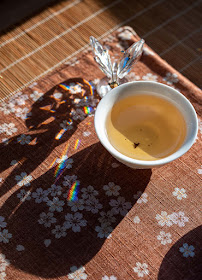 |
| 2010 fall top OB |
Brewing tea in a bowl is one of the most simple preparation method. Yes, you can find it in certain Taiwanese tea houses, but you can also see that most Taiwanese tea producers use this method to test their teas. Tea farmers only use the competition method for formal events. In everyday life, most producers I've met in Taiwan use a white bowl (sometimes the bowl from the competition set, sometimes a rice bowl) and brew their tea inside the bowl. The leaves keep on steeping and the farmer use a (porcelain) soup spoon to pour some tea in his cup and taste the tea. And when there's not much liquid left in the bowl, he adds boiling water.
When the farmer brews in a bowl, it's because he wants to push the tea to its limit and test the taste of the leaves when they brew for a very, very long time. It's the easiest way to tell if the tea is good or not: get all the flavors out of the leaves in one long steep.
But we tea drinkers brew like this for different reasons.
The bowl with its round shape is the ancestor of our tea cups. Big tea bowls are accessories from the past and each shape can be linked to a certain style or particular Chinese dynasty. Tang dynasty bowls were quite shallow and large. Song dynasty bowls were taller and 11.5 cm to 13 cm wide. Their shape were more suitable for whisking green tea powder. A shallow and large tea bowl (like here) will cool down faster. Therefore, it will only extract the lightest flavors from the leaves. That's why it's best to use it in summer. Under the sun, the (preheated) bowl is warm enough to release enough flavors and the brew will soon see its temperature drop and feel cooler than the hot brew from an Yixing teapot.
In terms of harmony and beauty, a tea bowl is also the most simple and harmonious vessel. And it lets you see the leaves unfold and dance with the boiling water you're adding on them. Watching the leaves turn in the bowl is like watching a clock turn, life unfold. They make a circle or two as the color of the brew darkens. Usually all these transformations are hidden in the teapot. Now you get to see the leaves soak the water and regain their original size.
This method is particularly well suited for green teas, because these teas are meant to have light flavors. However, as you can see here, it's also possible to enjoy Oriental Beauty Oolong or a Baozhong. (If you choose a partially oxidized tea, it's best to select one that doesn't have tightly rolled leaves like a high mountain Oolong. Because of the quick temperature drop in the bowl, twisted leaves open up much better than rolled leaves. - By the way, to solve the loss of temperature problem, a lid was added to the bowl and this created the gaiwan!-)
It brings out the lighter side of your Oolong teas. Less aftertaste, but more sweetness and delicate fragrances. The result is delicious! Especially if it's a good quality Oolong, it can take a very long brew. Here, my fall 2010 top Oriental Beauty feels pure and smooth. It's as if I had poured sugar in it!

































